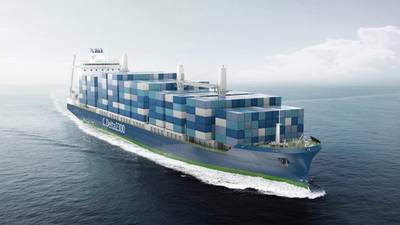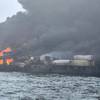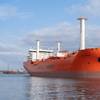Deltamarin Unveils LNG-powered Containership Design
Deltamarin introduced a new liquefied natural gas (LNG)-powered Kielmax container vessel design as vessel owners and operators increasingly turn to the cleaner burning fuel to help reduce shipping emissions.
The C.Delta2100 design, part of the Finnish naval architect's C.Delta series, is engineered to offer improved cargo capacity, flexibility and fuel economy and also takes into consideration possibilities to use alternative fuels to reduce carbon footprint or even zero-emissions power production. The vessel's length, breadth, block coefficient in combination with a larger propeller lead to higher speeds at lower power demand at the design speed/contract point compared with reference designs, Deltamarin said.
The platform design includes ice class 1A for unlimited Baltic Sea operation. The vessel is equipped with lashing bridges to access reefer containers.
The C.Delta2100 provides a container capacity of 2,100 TEU in four cargo holds and on deck. According to the designer, the increased cargo hold breadth improves stability in the fully laden condition, resulting in an increased utilization rate of about 75% (1,595 TEU) of nominal container intake in the homogeneous loading condition at scantling draught carrying a’ 14t TEU containers. Furthermore, intake can be optimized to a specific cargo profile and even further improved by considering route-specific loading.
Container sizes L 20’/40’/45’x B 8’/2500mm x H 8’6/9’6, able to accommodate pallet wide, HC containers in holds (max. 5 tiers) and on hatches, 45’ container bays arranged on some of hatch covers as well as one bay in the hold.
The high flexibility of the C.Delta2100 allows pallet-wide 40’ container stowage as well as three tiers of high cube containers in the cargo hold without losing container slots, while a high number of reefer plugs allows smart stowage and the reduction of unnecessary container movements.
Deltamarin said extensive effort has been focused on the C.Delta2100 hull form to ensure low resistance combined with high propulsion efficiency. This included dozens of CFD calculations and three series of model tests at the Hamburg Ship Model Basin (HSVA). The performance has been proven in C.Delta2150 sea trials.
The daily main-engine fuel oil consumption using LNG (tier III) 30.8 t/day + pilot oil 0.8 t/day at a 18-knot service speed results in fuel efficiency of less than 0.015t LNG/TEU/day at design draft.
A low deadweight per TEU ratio of about 15.2 DWT/14t TEU is thus achieved, which is commonly gained only in larger containerships. The vessel complies with EEDI Phase 3.
Length overall:179.4 m
Breadth: 31 m
Draught, design: 8.5 m
Draught at Kielmax: 8.5 m
Draught, scantling: 10 m
Capacity: 2,100 TEU
Capacity at 14 t/TEU: 1,595 TEU
Reefer plugs: 450
Deadweight at design draught: 18,500 t
Deadweight at Kielmax draught (FW): 17,750 t
Deadweight at scantling draught: 25,300 t
Service speed (15% sea margin): 18 kn
Main engine: MAN 6G60ME-C10.5-GI-EcoEGR-TIII or equivalent
SMCR: 11,500 kW
NCR: 9,775 kW
LNG tank capacity: 2*480 m3
Optional features of the C.Delta series include higher LNG capacity, methanol, ammonia, hydrogen as fuel, a flexible number of reefer plugs, shaft generator PTO/PTI as well as several ice classes.












